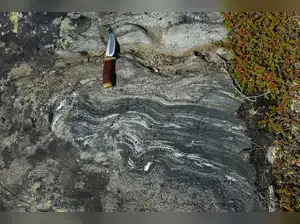Rock in Canada’s north may be a surviving remnant from Earth’s fiery infancy
An isolated and wind-blasted stretch of Canada’s Hudson Bay shoreline may hold the oldest surviving fragment of our planet's crust, a discovery scientists say could open a new chapter in Earth’s early history.
Hadean eon era
Researchers have determined that a section of the Nuvvuagittuq Greenstone Belt, a rocky formation in northern Quebec, is at least 4.16 billion years old. That pushes the timeline of Earth’s known crust further back than ever before, into the mysterious Hadean eon, a time when Earth was a fiery, molten world.
The Acasta Gneiss Complex, located along a riverbank about 200 miles (300 kilometers) north of Yellowknife in northwestern Canada, is widely recognized as the oldest confirmed geological formation on Earth.
“Rocks are books for geologists,” said Dr. Jonathan O’Neil, the University of Ottawa geologist behind the study. “Right now, we’re missing the book on the Hadean. The Nuvvuagittuq Greenstone Belt would be at least one page of that book.”
The findings, published in the journal Science, are the most robust evidence yet that remnants of Earth's earliest crust still survive. Previous estimates for the belt’s age ranged widely, from 3.75 billion to 4.3 billion years, but this study employed a rare earth element technique to achieve greater precision.
Because the rocks don’t contain the mineral zircon, the standard “clock” for dating ancient rocks, O’Neil’s team used samarium-neodymium dating, which relies on isotopes that only formed in the planet’s earliest days. The results from two separate isotopic "clocks" both pointed to 4.16 billion years.
For perspective, that’s just 400 million years after Earth itself formed when the surface was barely solid and life was still a possibility, not a certainty.
“This is as close as we get to Earth’s birth certificate,” said Dr. Jesse Reimink of Penn State University, who was not involved in the study.
However, some experts remain cautious. Dr. Hugo Olierook of Curtin University in Australia said the technique has limitations and could be influenced by later geological changes. “It only takes one altered mineral to reset the age,” he warned.
Cultural relevance
Beyond the science, the rocks have cultural weight. The land belongs to Inuit communities, who are calling for more protection after some samples were damaged or taken without consent.
“We understand the rocks are important, but so is respect for our land,” said Tommy Palliser of the Pituvik Landholding Corporation.
Still, the discovery may help answer some of the oldest questions humans have ever asked, about our planet’s first days and perhaps even the origins of life itself.
Hadean eon era
Researchers have determined that a section of the Nuvvuagittuq Greenstone Belt, a rocky formation in northern Quebec, is at least 4.16 billion years old. That pushes the timeline of Earth’s known crust further back than ever before, into the mysterious Hadean eon, a time when Earth was a fiery, molten world.
The Acasta Gneiss Complex, located along a riverbank about 200 miles (300 kilometers) north of Yellowknife in northwestern Canada, is widely recognized as the oldest confirmed geological formation on Earth.
“Rocks are books for geologists,” said Dr. Jonathan O’Neil, the University of Ottawa geologist behind the study. “Right now, we’re missing the book on the Hadean. The Nuvvuagittuq Greenstone Belt would be at least one page of that book.”
The findings, published in the journal Science, are the most robust evidence yet that remnants of Earth's earliest crust still survive. Previous estimates for the belt’s age ranged widely, from 3.75 billion to 4.3 billion years, but this study employed a rare earth element technique to achieve greater precision.
Because the rocks don’t contain the mineral zircon, the standard “clock” for dating ancient rocks, O’Neil’s team used samarium-neodymium dating, which relies on isotopes that only formed in the planet’s earliest days. The results from two separate isotopic "clocks" both pointed to 4.16 billion years.
For perspective, that’s just 400 million years after Earth itself formed when the surface was barely solid and life was still a possibility, not a certainty.
“This is as close as we get to Earth’s birth certificate,” said Dr. Jesse Reimink of Penn State University, who was not involved in the study.
However, some experts remain cautious. Dr. Hugo Olierook of Curtin University in Australia said the technique has limitations and could be influenced by later geological changes. “It only takes one altered mineral to reset the age,” he warned.
Cultural relevance
Beyond the science, the rocks have cultural weight. The land belongs to Inuit communities, who are calling for more protection after some samples were damaged or taken without consent.
“We understand the rocks are important, but so is respect for our land,” said Tommy Palliser of the Pituvik Landholding Corporation.
Still, the discovery may help answer some of the oldest questions humans have ever asked, about our planet’s first days and perhaps even the origins of life itself.








